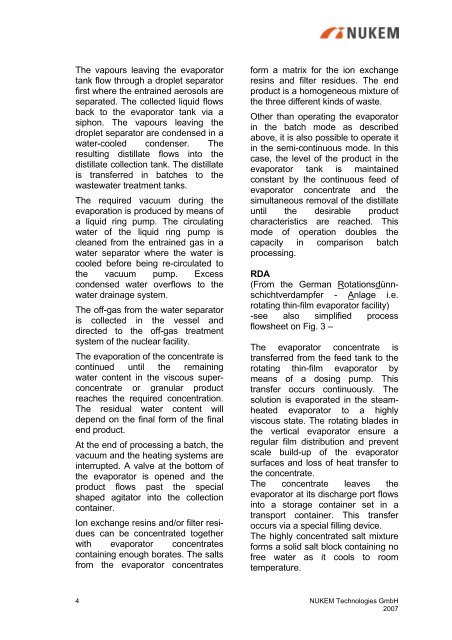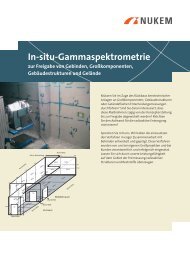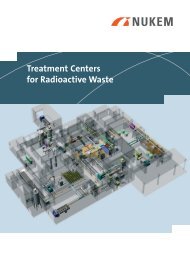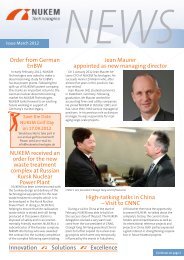Concentration of Evaporator Concentrates - NUKEM Technologies
Concentration of Evaporator Concentrates - NUKEM Technologies
Concentration of Evaporator Concentrates - NUKEM Technologies
Create successful ePaper yourself
Turn your PDF publications into a flip-book with our unique Google optimized e-Paper software.
The vapours leaving the evaporator<br />
tank flow through a droplet separator<br />
first where the entrained aerosols are<br />
separated. The collected liquid flows<br />
back to the evaporator tank via a<br />
siphon. The vapours leaving the<br />
droplet separator are condensed in a<br />
water-cooled condenser. The<br />
resulting distillate flows into the<br />
distillate collection tank. The distillate<br />
is transferred in batches to the<br />
wastewater treatment tanks.<br />
The required vacuum during the<br />
evaporation is produced by means <strong>of</strong><br />
a liquid ring pump. The circulating<br />
water <strong>of</strong> the liquid ring pump is<br />
cleaned from the entrained gas in a<br />
water separator where the water is<br />
cooled before being re-circulated to<br />
the vacuum pump. Excess<br />
condensed water overflows to the<br />
water drainage system.<br />
The <strong>of</strong>f-gas from the water separator<br />
is collected in the vessel and<br />
directed to the <strong>of</strong>f-gas treatment<br />
system <strong>of</strong> the nuclear facility.<br />
The evaporation <strong>of</strong> the concentrate is<br />
continued until the remaining<br />
water content in the viscous superconcentrate<br />
or granular product<br />
reaches the required concentration.<br />
The residual water content will<br />
depend on the final form <strong>of</strong> the final<br />
end product.<br />
At the end <strong>of</strong> processing a batch, the<br />
vacuum and the heating systems are<br />
interrupted. A valve at the bottom <strong>of</strong><br />
the evaporator is opened and the<br />
product flows past the special<br />
shaped agitator into the collection<br />
container.<br />
Ion exchange resins and/or filter residues<br />
can be concentrated together<br />
with evaporator concentrates<br />
containing enough borates. The salts<br />
from the evaporator concentrates<br />
form a matrix for the ion exchange<br />
resins and filter residues. The end<br />
product is a homogeneous mixture <strong>of</strong><br />
the three different kinds <strong>of</strong> waste.<br />
Other than operating the evaporator<br />
in the batch mode as described<br />
above, it is also possible to operate it<br />
in the semi-continuous mode. In this<br />
case, the level <strong>of</strong> the product in the<br />
evaporator tank is maintained<br />
constant by the continuous feed <strong>of</strong><br />
evaporator concentrate and the<br />
simultaneous removal <strong>of</strong> the distillate<br />
until the desirable product<br />
characteristics are reached. This<br />
mode <strong>of</strong> operation doubles the<br />
capacity in comparison batch<br />
processing.<br />
RDA<br />
(From the German Rotationsdünnschichtverdampfer<br />
- Anlage i.e.<br />
rotating thin-film evaporator facility)<br />
-see also simplified process<br />
flowsheet on Fig. 3 –<br />
The evaporator concentrate is<br />
transferred from the feed tank to the<br />
rotating thin-film evaporator by<br />
means <strong>of</strong> a dosing pump. This<br />
transfer occurs continuously. The<br />
solution is evaporated in the steamheated<br />
evaporator to a highly<br />
viscous state. The rotating blades in<br />
the vertical evaporator ensure a<br />
regular film distribution and prevent<br />
scale build-up <strong>of</strong> the evaporator<br />
surfaces and loss <strong>of</strong> heat transfer to<br />
the concentrate.<br />
The concentrate leaves the<br />
evaporator at its discharge port flows<br />
into a storage container set in a<br />
transport container. This transfer<br />
occurs via a special filling device.<br />
The highly concentrated salt mixture<br />
forms a solid salt block containing no<br />
free water as it cools to room<br />
temperature.<br />
4<br />
<strong>NUKEM</strong> <strong>Technologies</strong> GmbH<br />
2007







